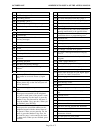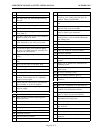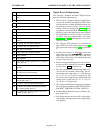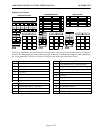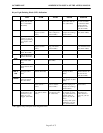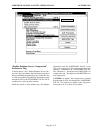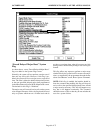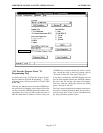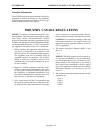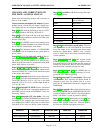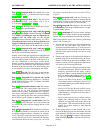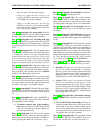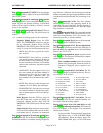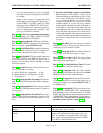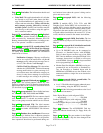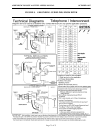
ADDENDUM TO ISSUE 4 OF THE AXXESS MANUAL OCTOBER 1997
Page 69 of 73
— Intercom callers will hear busy signals.
— Callers on a trunk that does not have to be
seized forAXXESS to return busy signal (such as
a T1 E&M) will hear busy signals.
— Callers on a trunk that has to be seized for
AXXESS to return busy signal (such as a non-T1
loop-start) will hear ringing and the call will be
sent to the primary attendant.
Page 4–14, paragraph 6.11, second bullet: The first
sentence should read as follows: Stations that are busy
and have their calls unconditionally forwarded...
Page 4–14, paragraph 6.13, last bullet and page
6–87, last timer: The Average Connect Time Per Call
timer is available only in UCD hunt groups. ACD hunt
groups can only use the timer if they are also flagged as
UCD.
Page 4–16, paragraph 6.31: This paragraph should
read as follows: UCD priority levels range from 0 (low)
to 75 (high). If a station is a member of multiple hunt
groups that have the same priority level, calls received
by those hunt groups will be queued in the order they
were received by the phone system. (Non-UCD hunt
groups are treated as if they have a priority level of 0.)
Page 4–17, paragraph 6.33: Single-line stations can
be programmed as hunt group supervisors. Therefore,
the first sentence should read: In database program-
ming, each hunt group can have one or more
stations
assigned as the hunt group supervisor(s).
Page 4–17, paragraph 6.36: The first sentence should
read: If the supervisor attempts to monitor a station that
is not on an active call that allows monitoring, the sys-
tem sends reorder tones and the supervisor must enter
the feature code again to try another number.
Page 4–17, paragraph 6.37: Add the following: Multi-
ple supervisors can monitor the same station, providing
that a conference circuit is available for each supervi-
sor.
Page 4–17, paragraph 6.39: In step 2, the MUTE key
does not light. In step 3, remove the “OR” statement.
The step should read as follows:
(3) To monitor another hunt group member’s
call: Enter the Station Call Monitoring feature
code (321), and dial the extension number (or
press the speed-dial key).
Page 4–21, paragraph 7.3: The second sentence
should read as follows: While on a dial-pulse trunk, a
station user can switch from dial-pulse to DTMF sig-
nals by pressing the pound (#) or asterisk (*) keys.
Page 4–28, paragraph 7.39, third bullet: It should re-
fer to page 6–31 instead of page 6–97.
Page 4–29, paragraph 7.42: The second sentence
should read as follows: If the camp-on feature is dis-
abled, callers will hear continuous busy signals when
all trunks in the trunk group are in use or unavailable.
Page 4–30, paragraph 7.53, second sample: The first
sentence should say: This is an ANI table for various
area codes.
Page 4–33, paragraph 7–55, third bullet: Add this in-
formation: If SMDR is enabled, the modified telephone
number, not the dialed digits, appear in the SMDR call
record.
Page 4–34, paragraph 7.61: The third sentence should
read as follows: However, if the trunk is marked as
“subject to toll restriction” and the user attempting to
make the outgoing call dials one or more digits before
realizing that there is an incoming call, and the digits
dialed represent a restricted number for the station and
trunk group being used, the call will be dropped (unless
the “Drop Incomplete Outgoing Calls” flag is disabled
as described on page 6–98 in PROGRAMMING).
Pages 4–46, 6–54, and 6–59, descriptions of keys:
Change the descriptions for the following two keys:
•
Down Key: (This key type is not required for digital
keysets.) No further programming is necessary.
This key can be used scrolling backward through
displays. When the keyset is idle, it can be used for
adjusting volume, in place of the VOLUME key.
(Digital Keysets use the VOLUME DOWN key.)
•
Up Key: (This key type is not required for digital
keysets. It is intended for analog keyset use.) No
further programming is necessary. This key can be
used for scrolling forward through displays. When
the keyset is idle, it can be used for adjusting vol-
ume, in place of the VOLUME key. (Digital keysets
use the VOLUME UP key.)
Page 4–52, paragraph 8.65, second bullet and page
6–99, first bullet: The information should read as fol-
lows:
•
Use Green LEDs For Direct Ring: This flag de-
termines whether direct ring-in calls cause a red or
green lamp. If the flag is enabled, direct ring-in
calls to your station will be green. If disabled, all
direct ring-in calls will cause the LED to be red. In
the default state, this flag is enabled.
Page 4–56, paragraph 8.90: The paragraph should
read as follows: With ring zones enabled, devices 1–3
on the card will ring first, 4–6 ring next, then 7–8.



